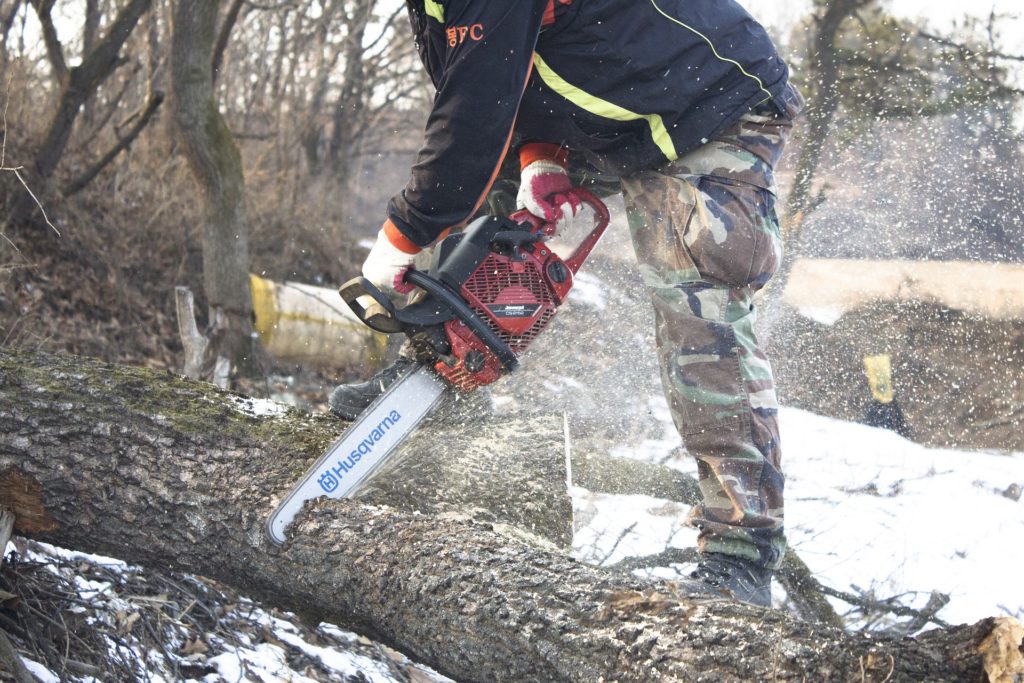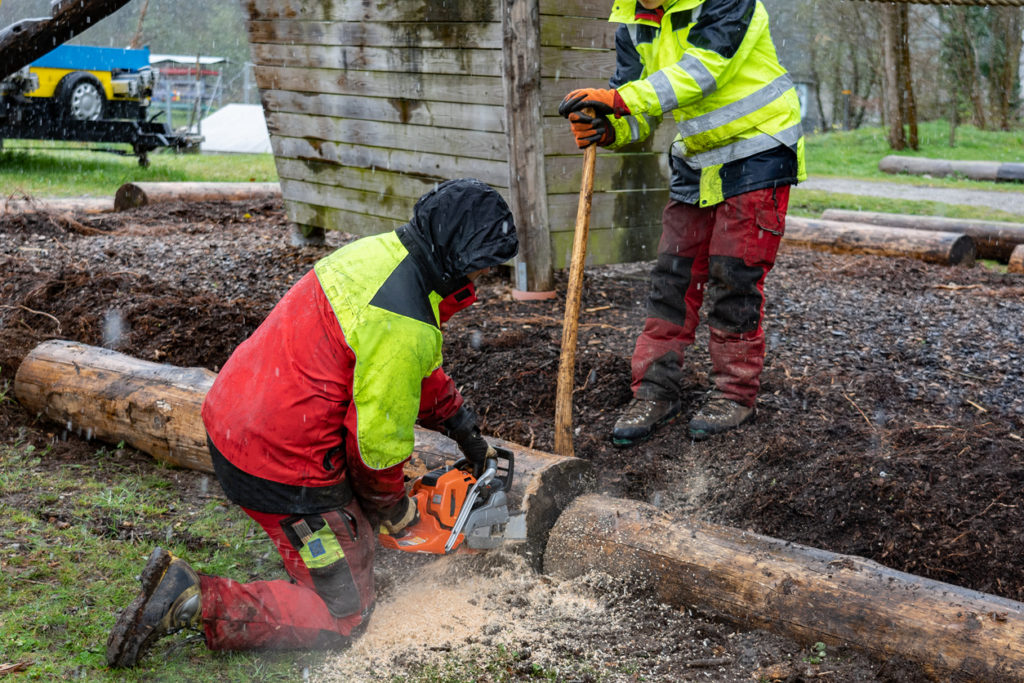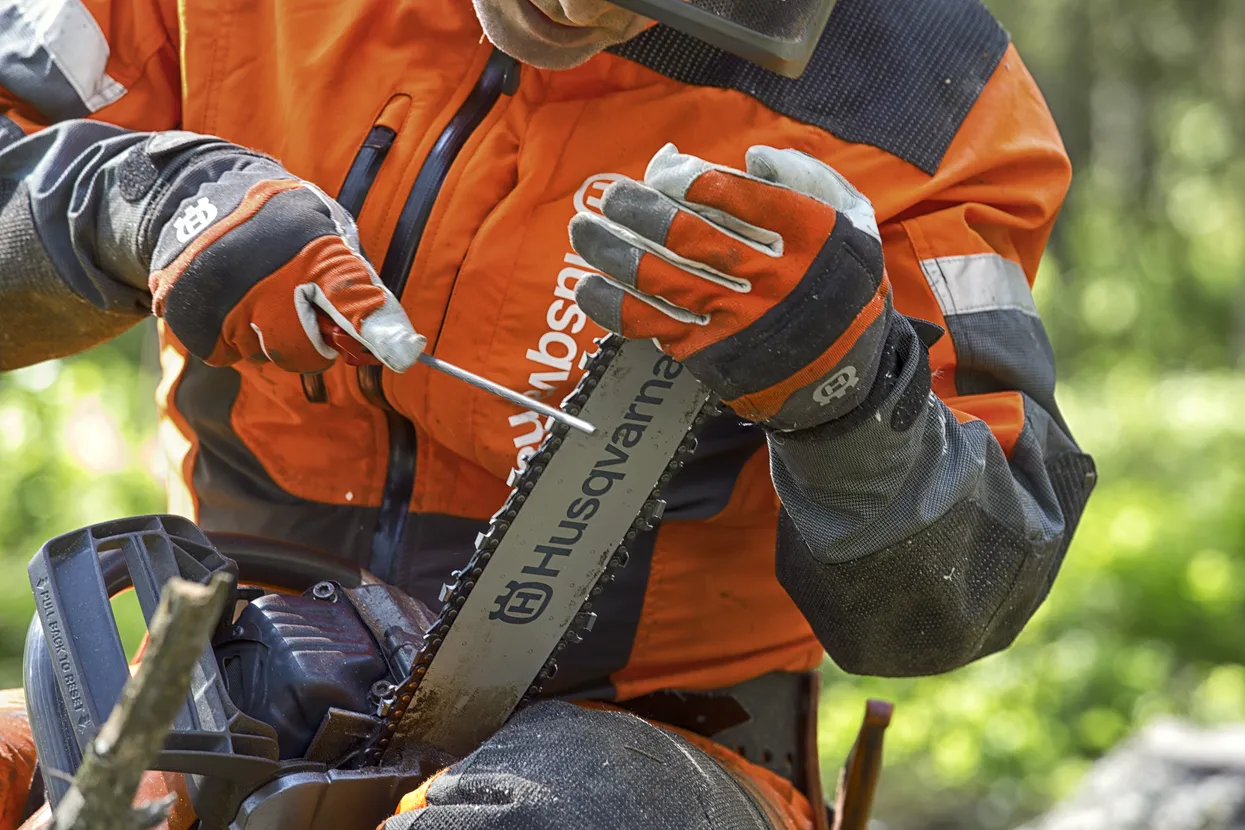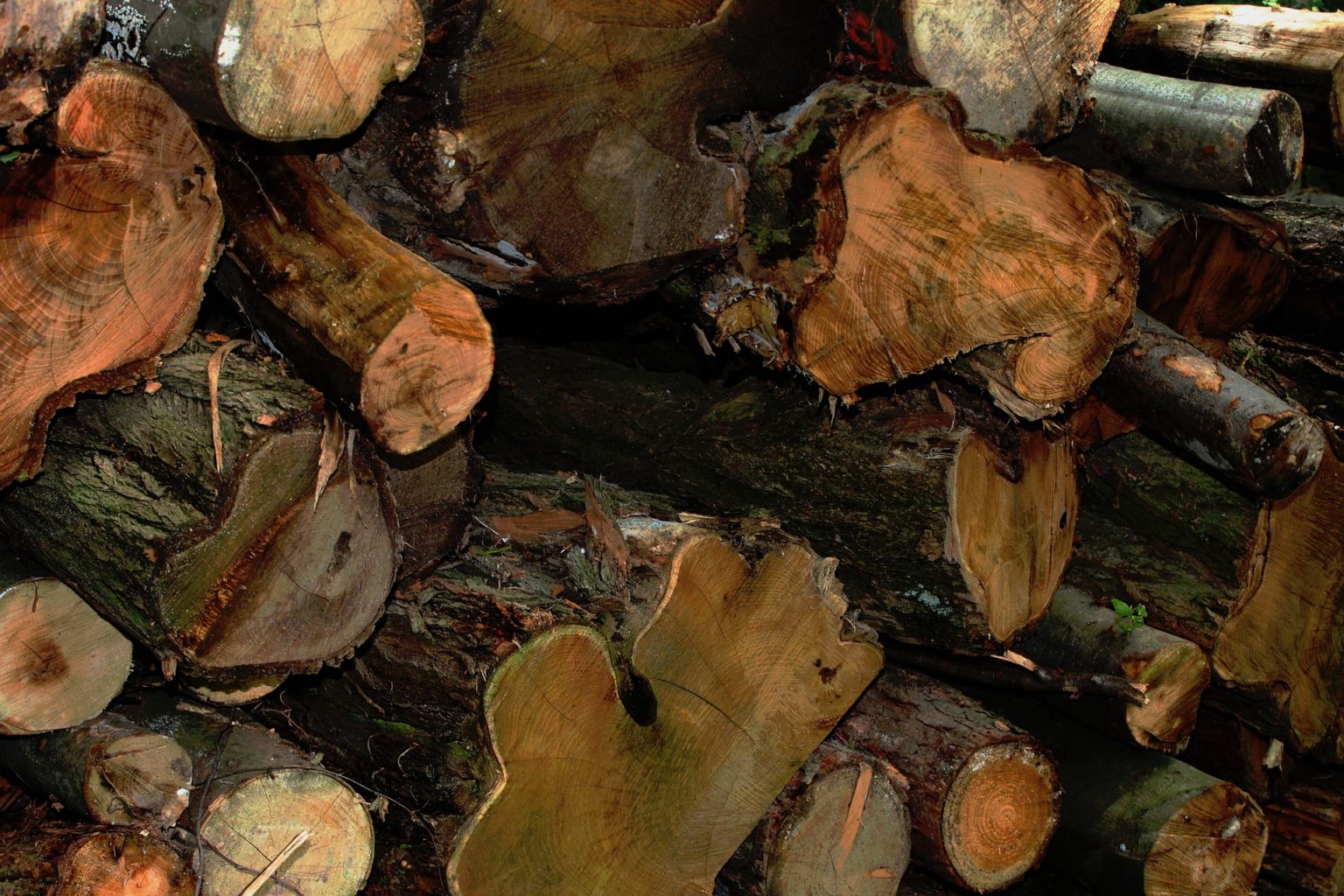If you live in a part of the country where rain falls all year and you have a backyard to take care of, you may have asked yourself, “Can you cut wet wood with a chainsaw?” The simple answer to this question is yes, but there is more to it than that.
If you plan to cut up some wood that has been exposed to the elements, pretty much any chainsaw will be up to the task. However, there are a few things that you should bear in mind before you start sawing. This post will cover the precautions you should take before using a chainsaw in inclement weather, and we will explain how it is density and not moisture that makes cutting through wood more difficult.
Can You Chainsaw Wet Wood?

There are many different types of wood, and some of them are a lot harder to cut through than others. Even a lightweight chainsaw designed for basic gardening tasks could cut through balsa wood with ease, but dealing with logs composed of a denser wood like mahogany or maple would be far more difficult and likely require a more robust tool. The condition of wood also influences how easy it is to cut. A fresh balsa log could be more difficult to cut through than a dead or diseased piece of oak. It is best to approach each job as if the wood you will be cutting is alive, green, and in its prime.
The amount of moisture a piece of wood contains does not significantly affect how a chainsaw works, but dry wood does weigh less than wet wood. Chainsaws work best when their chains are well lubricated, which is why guide bar oil is so important. The water in wood is a natural lubricant, and it reduces the friction that is created when chains moving at high speeds come into contact with wood fibers. Guide bar oil reduces resistance and maintains chain speed when cutting through wood.
Does Wet Wood Dull a Chainsaw?
The common belief that wood with a lot of moisture in it dulls chains is not based on science. Adding moisture improves lubrication, which means that cutting wet wood puts less stress on your chainsaw than cutting dry wood. Reducing friction also keeps chains sharp.
One thing that will change when you use a chainsaw to cut through wet wood is the way you deal with sawdust. When you cut through dry wood, sawdust fills the air and is blasted away by the saw’s exhaust. When you cut wet wood, damp sawdust forms into clumps that can stick to chains and gum up sprockets. This can drain power and impede performance, so frequent stops may be necessary to remove the gunk. Keep safety at the front of your mind when you do this, and take an extra moment to fill up your saw’s oil tank before you get back to work.
Working in Wet Conditions

Wet wood is easier to cut and does not harm chainsaws, but the places where it is found can be quite treacherous. Slippery ground, high winds, and driving rain can all make working outdoors more dangerous, so extreme caution should be taken when operating powerful cutting tools in these conditions. Before you fire up your chainsaw in the rain or snow, here are a few things you might want to consider:
- The weather forecast: Clear skies can turn gray in a matter of minutes, and downpours sometimes appear out of the blue. If you plan to work outdoors, you should check the weather forecast before you plan your activities for the day.
- The order of business: If you are clearing up after a snowstorm, and more bad weather is on the way, you may be tempted to get started right away. While this is understandable, you should clear the area first, as accumulated snow can conceal many hazards.
- Communication: Wind and rain can make being seen and heard more difficult, so make sure that you wear bright clothing and have a communications strategy in place if you plan to work with others in inclement weather.
- Appropriate clothing: If you go outside to cut wet wood with a chainsaw, there is a good chance that you will have to contend with rain or low temperatures. In these conditions, you should dress in layers that you can discard as your body warms up. It is also important to make sure that your outer layer is waterproof.
- Guide bar oil: Moisture in wood provides a natural lubricant, but it cannot replace guide bar oil. Make sure that you use a quality mineral oil when you cut wet wood, and top up the reservoir every time you stop to remove damp sawdust. A well-oiled chain resists rust and lasts longer.
- ECO-FRIENDLY LUBRICANT: With ultimate biodegradability, our green, non toxic chainsaw oil is made from North American grown plant oils, so it’s safer for you, safer for your pets and safer for the environment than petroleum based products.
- HIGH PERFORMANCE: Our professional Pro100 Bar & Chain Oil has a high flash point up to 600°F and excellent temperature stability even in extreme conditions. The all season bio-based commercial quality lubricant has a minus 20°F pour point.
- PROFESSIONAL QUALITY: Safer for your employees and better for your equipment, our yard-safe supreme grade chainsaw oil offers outstanding lubricity, superior wear protection, and is high tack to reduce high speed oil sling.
- NON TOXIC FORMULA: Containing no petroleum base oils or metal-based additives, our eco-friendly lubricant is ideal for chainsaws as they are 100% loss applications. This green lube is suitable for use around waterways and other sensitive areas.
- MADE IN THE USA DEWALT Bar & Chain Oil is USDA Certified Bio-based Product
- Your power source: Plugging an electric chainsaw into an extension cord could be perfectly safe in some situations, but this would be an incredibly dangerous arrangement in a storm. Gas-powered chainsaws shrug off inclement weather, but water can still damage them if it finds its way into the fuel and oil mixture.
- DIMENSIONS: External size for this extension cord cover is 2.3" x 2.3" x 7.1" and its inner size is 2.0" x 2.0" x 5.3". The diameter of entry port is 10mm that perfect to seal 14/16/18 gauge cord, braided cable and flat wire. Designed to keep cord connection secure and protected.
- Compact size and light weight are great to protect outlet/plug/socket/connection hanging in the air. With the 4 corner clips, snap-lock lid, and rubber gaskets, this outdoor extension cord cover box is IP44 waterproof.
- Made with heavy-duty reinforced PP material to withstand rain, snow, water, dust, dirt and more, continuously protecting outdoor connections from electrical hazard.
- Easy to use, place the connection into the safety seal enclosure and clip the cord with the clamps. To hang the cover, use the included cable ties and insert them to the side mounting holes.
- Ideal for a wide range of outdoor & indoor applications including lawn and garden power tools, Christmas holiday lighting, landscape decorations, pool pumps, fountains, fish ponds, patio heaters, air conditioners, security cameras and more.
- Slippery footing: Water lubricates the ground as well as the wood, so you can expect the conditions underfoot to be treacherous if you venture outside after a rainstorm. Slips and falls cause millions of sprains, strains, and contusions each year. You need to do all you can to avoid mishaps in wet weather even when you’re not using a chainsaw.
- GRIPS ON SLIPPERY SURFACES: Walk confidently with these slip-on traction cleats designed to evenly distribute underfoot traction across ice- and snow-covered surfaces, as to provide stability on rocky terrain.
- STAYS STRONG IN COLD WEATHER: Thermoplastic rubber sling won't degrade, crack, or fail in cold temperatures for durability that lasts through repeated uses; plus, the thermoplastic is completely recyclable for reduced waste
- 360-DEGREE UNDERFOOT TRACTION: Innovative coil technology provides 360-degree stability when walking forward, backward, or even laterally across snow-packed surfaces
- EASY ON, EASY OFF: Thermoplastic sling with heel tab for easy installation and removal combines the stretchability of rubber for a comfortable fit over a variety of footwear shapes and sizes with the durability of plastic that stays secure when in use
- COMFORTABLE, MULTI-SURFACE TRACTION: Coils are crafted of durable, corrosion- and abrasion-resistant steel that adapts to different terrains, with no sharp edges to damage surfaces, footwear, or equipment.
- Special chains: There are companies that make chainsaw chains for all sorts of specialized applications, but the success of these products is sometimes based on hype rather than performance. A saw that can cut through dry wood will cut through wet wood with ease, so there is no need to purchase a special chain. If you have to cut frozen or particularly dense wood, you may need a micro chisel chain whether the material is wet or dry.
- Chainsaw specifications: Chainsaws are available in several sizes and configurations, and the amount of material they can cope with is based on the length of their guide bars and the power of their engines. Cutting wet wood may be a bit easier than cutting dry wood, but it does not make your chainsaw any more capable.
- Personal protective equipment: Anybody who operates a chainsaw should wear protective equipment. Eye protection, robust footwear, and tough work gloves provide a good safety foundation, but they do not protect as well as the latest chainsaw chaps or pants. These protective garments are made out of advanced materials that shred on impact, clog up drive sprockets, and stop chainsaws in their tracks.
- Husqvarna Classic Personal Protective Power Kit includes: one pair of Husqvarna classic chaps (homeowner) (36 to 38 inches, 32-inch inseam), one Husqvarna functional forest helmet, and one pair of Husqvarna classic work gloves (large)
- Ensure Proper Protection: These chainsaw accessories are an easy way to ensure that new chainsaw owners are properly covered with the appropriate personal protective equipment
- Reduce Risk of Injury: 5-layer chainsaw chaps are designed to reduce risk of chainsaw injuries; chainsaw helmet has an HDPE shell with face shield, ear muffs and a sun peak; lightweight chainsaw gloves with synthetic leather palm are great for general use
- Hi-Vis orange makes this chainsaw holder easy to identify on busy job sites and in tree-trimming settings
- Certified Forestry Tools: Chainsaw chaps and helmet meet ASTM F1897, ANSI Z133.1 and OSHA Regulation 1910-26, and hearing protectors have a 24dB(A) NRR rating
Cleaning a Wet Chainsaw

Cutting wet wood can be a messy business, which means cleaning up can take almost as long as sawing. These chores should be seen as a form of preventive maintenance, and they cannot be neglected if you want your saw to provide years of faithful service. When your wet wood has all been cut and it’s time to put your saw away, here are the steps to take:
- Clean the chain: The first thing you should do is remove any damp sawdust from your saw’s chain. You can poke the sawdust out or brush it away, but make sure that you do a thorough job.
- Dry the chain: Rust is the nemesis of chainsaw chains, and it does not need much moisture to take root. Before you put your saw away, dry the chain thoroughly, then apply a thin coat of mineral oil for additional protection.
- Mop up any water beads: Use a clean, dry cloth to remove water spots from your chainsaw. Pay particular attention to metal components that could rust.
- Clean the air filter: Damp sawdust does not form thick clouds in the air, but it can still clog air filters. A minute or so under a running tap should be all that is needed to bring your chainsaw’s air filter back to pristine condition.
- Clear out the sprocket cover: Wet sawdust often forms into clumps that become hard when they dry. When these clumps accumulate under sprocket covers, they can cause starting problems and impede performance.
Choosing a Chainsaw for Cutting Wet Wood
If you are thinking about getting a chainsaw, you should look for a tool that is appropriate for the type of work you will be doing. This basically comes down to making two decisions. You have to choose a power source, and then you need to pick the right size. Let’s look at those options a little more closely:
- Battery power: Most electric chainsaws now have battery packs instead of plugs and cables, and some of them are quite powerful. Electric chainsaws are lighter and quieter than gas-powered saws, and they do not vibrate nearly as much. Recharging a battery takes longer than filling a fuel tank, but electric chainsaws are virtually maintenance-free.
- Ditch the gasoline, extension cords and maintenance required with alternative chainsaws
- Brushless motor maximizes both the torque and the lifespan of the unit
- 16-inch chain runs at speeds of up to 49 feet per second
- Included 40-Volt 4Ah fade-free lithium-ion battery and charger compatible with the entire WEN 40V Max Series
- Backed by a two-year warranty
- Gas power: The large chainsaws used by professionals almost always have two-stroke engines that are powered by a mixture of gas and oil. These saws can handle the toughest jobs, but keeping them in tip-top condition requires a lot of TLC. Be very careful if you ever add fuel to one of these chainsaws in the rain. If the fuel-air mixture is contaminated by water, your saw could stutter, run hot, or cut out.
- Powerful Engine: 2-cycle 58 cc engine provides more power, perfect for cutting jobs around garden or far
- Durable Chainsaw: The chainsaw will make tasks like tree pruning, clearing land, preparing firewood or cleaning up after a storm easier
- Anti-Vibration System: It reduces vibration levels, for more comfortable use of chainsaw
- High Safety: The quick stop chain brake helps to use more securely; The chain saw is provided with a safety switch to protect against accidental starts to ensure the safety of the user
- Easy Start: Equipped with a designed engine and starter for easy and fast starting with minimum effort
- Guide bar size: Chainsaws with longer guide bars can cut thicker logs, but that extra performance comes with a price attached. Longer chains require large and powerful engines that consume more fuel, so these chainsaws tend to be much heavier. Consider the sizes of the branches or logs you will be cutting, and then lean toward shorter rather than longer when picking a guide bar length.
We Have the Information You Deserve
If you have questions about using or maintaining a chainsaw, ChainsawSelector almost certainly has the answers you are looking for. Our blog posts can help you to avoid common mistakes, and they could also point you in the right direction if your chainsaw begins to act up. When the time comes to replace your old chainsaw with a brand-new model that has the latest features, our reviews and product roundups will give you the information you need and tell you about each saw’s disadvantages as well as its benefits.


![Flemoon [3 Pack] Outdoor Extension Cord Safety Cover with Waterproof Seal, Weatherproof Electrical Connection Box to Protect Outdoor Outlet, Plug, Socket, Christmas Holiday Decoration Light, Black](https://m.media-amazon.com/images/I/41IfF34O4IL._SL160_.jpg)



